 Q It Up: Attention road warriors! Describe your portable studio. Is it a nicely decked out laptop, or have you minimized even further to an iPad or even your mobile phone for recording? What are you using for mikes and recording and editing software and what do you like about these choices? Are you mainly voicing, producing, or doing both on your system? If doing voicework, how do you deal with soundproofing? Do you keep the package light with earbuds instead of regular headphones? Are you using external drives? What have you learned from building and using your portable studio, and what would you have done differently, if anything? How would you build the next one?
Q It Up: Attention road warriors! Describe your portable studio. Is it a nicely decked out laptop, or have you minimized even further to an iPad or even your mobile phone for recording? What are you using for mikes and recording and editing software and what do you like about these choices? Are you mainly voicing, producing, or doing both on your system? If doing voicework, how do you deal with soundproofing? Do you keep the package light with earbuds instead of regular headphones? Are you using external drives? What have you learned from building and using your portable studio, and what would you have done differently, if anything? How would you build the next one?
Erik Cudd <erikcudd[at]hotmail.com>: I have been able to have a complete Voiceover Business and still be mobile thanks to Harlan Hogan. This may come off like a shameless plug, but I bought a package deal. I utilize a Harlan Hogan signature series MXL-VO1A microphone, and also use Harlan’s Porta-Booth Pro. I literally take my studio wherever I go. My mic is powered by the Centrance Mic Port Pro USB Adaptor which allows me to go from XLR at my mic to USB to my laptop. That is my entire mic chain! I run Adobe Audition 3.0 on my laptop and that’s it. For my laptop, Adobe software, mic, Porta Booth, one short XLR cable, Centrance Mic Port Pro, and one small desktop mic stand, I got a full and complete portable studio ready at all times all for less than $3,000.
Shaun Whynacht <shaun[at]bluecowcreative.ca>, Blue Cow Creative Design & Productions Ltd., Coldbrook, Nova Scotia, Canada: When it comes to being mobile, it’s all about being light. Our company does a lot of on location audio recording for podcasts, video productions and broadcasts. We have several pieces of equipment we use. Our favourite one is a MacBook Pro with M-Audio FastTrack Pro. We use AT2020’s for our on location two person interview situations. When recording live on location ambience, we opt for an ME66. Sometimes having a laptop is not the best situation, so we have to go more mobile. Recording into a Digital Marantz or H2 gives us the best portability. Because we are producing for the web, we don’t need to have the thousand dollar pieces of equipment that you would need for a blockbuster film. That allows us to keep our production costs at a reasonable rate and our clients happy.
Mike Bratton <studio[at]mwbproductions.com> Voice Guy: How appropriate that this question comes today, as I’m currently in Los Angeles, attending the ProMax convention… on the opposite side of the country from my main studio ( in Brooklyn, NY ).
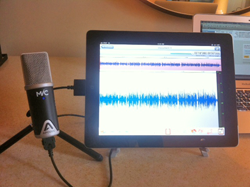 I’m tapping this out on my 11” MacBook Air, on which I run Pro Tools 10. For this trip, I brought along a little more hardware than normal, but that’s because I’m here for a week, instead of just a few days. The current kit includes: 11” MacBook Air, Avid MBox Mini, Sennheiser 416 Shotgun Mic, weird little flexible mic boom with a clamp on the end (forgive me, I’ve completely forgotten the brand and model!), 2 lengths of Mic Cable - 6ft and 10ft I think, Glyph Portagig 50 External HD, Verizon 4G JetPack Mobile HotSpot, and a baggie full of cables and chargers!
I’m tapping this out on my 11” MacBook Air, on which I run Pro Tools 10. For this trip, I brought along a little more hardware than normal, but that’s because I’m here for a week, instead of just a few days. The current kit includes: 11” MacBook Air, Avid MBox Mini, Sennheiser 416 Shotgun Mic, weird little flexible mic boom with a clamp on the end (forgive me, I’ve completely forgotten the brand and model!), 2 lengths of Mic Cable - 6ft and 10ft I think, Glyph Portagig 50 External HD, Verizon 4G JetPack Mobile HotSpot, and a baggie full of cables and chargers!
I carry all of it in a couple of different bags, but the best “studio backpack” I’ve found actually Steve Stone turned me on to a few years ago… from a company called MONO.
Typically, for shorter trips, I won’t carry anything as big as the MBox Mini. I’ll take the Shure x2u USB Preamp and my shotgun. If I’m going camping, but my clients like Fox Business or maybe an affiliate, would feel better having SOME way of getting audio from me, even in the woods, I’ll just take along my iPad, iPhone, and the Apogee MiC.
For a longer trip like this… I have all of the above with me. It doesn’t take up much room, and honestly, my MacBook Air and iPad weigh about as much as my older 13” MacBook Pro did by itself. I prefer a little added protection, in case one recording method blows up in my face, I’ve got 2 or 3 others waiting in the wings to bail me out. It really proves to be a good strategy too. I left my laptop and 416 at the hotel, went to a meeting, and on the way, got an urgent request for a revision for an East Coast client. I parked the car, jumped in the back seat, whipped out my iPad and Apogee MiC, and within minutes had the audio recorded, and uploaded via my 4G wireless hotspot. Boom.
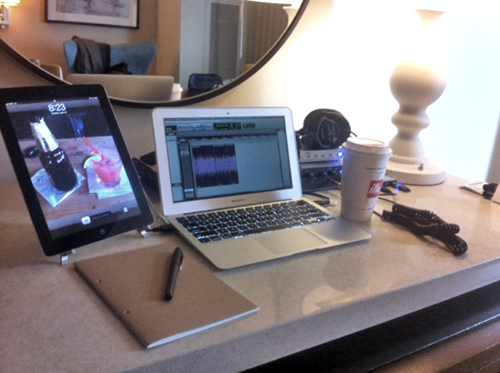
And when all else fails, or, just to REALLY make sure I’m covered… if at all possible, I make arrangements at other recording studios in the town I’m heading to, as either a place to record via ISDN, or just as a last line of defense.
If I can’t get into an ISDN facility, I’ll use Source Connect on my laptop, and contact a bridging service like Steve Nafshun’s “Out of Hear” studios in Los Angeles. The guy knows his ISDN, knows his Source Connect… and also has the ability to link up to users that have AudioTX ( PC Only ).
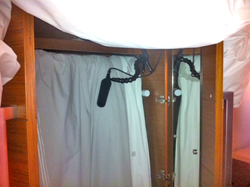 As for soundproofing… I have tried the Hogan Vocal Booth Pro, and I like it. I take it with me when I’m traveling by car typically. But honestly, I prefer to work standing up. If I’m at a hotel, I’ll just ask for a few extra blankets/comforters from housekeeping, and build myself a “VO Fort” in the closet or wherever I can find some space. It’s not perfect, but it works to deaden the typical sibilant ringing you’ll get in your average hotel room.
As for soundproofing… I have tried the Hogan Vocal Booth Pro, and I like it. I take it with me when I’m traveling by car typically. But honestly, I prefer to work standing up. If I’m at a hotel, I’ll just ask for a few extra blankets/comforters from housekeeping, and build myself a “VO Fort” in the closet or wherever I can find some space. It’s not perfect, but it works to deaden the typical sibilant ringing you’ll get in your average hotel room.
These days, it’s so easy to stay connected when you’re away, it’s almost a crime not to. And for the most part, you’re losing money if you don’t. That being said, a couple of times a year, I force myself to leave the toys at home and take a nice week-long vacation away from it all. Well, okay… maybe I still sneak the Apogee along for the ride too. Hey, you never know when a big audition is coming, right?
Steve Cook <steve[at]5talentsaudio.com>: This is good timing because my main workstation just crashed a couple of weeks ago and I was running portable for a whole week (albeit while I was NOT actually on the road!). I use the same software (Audition) on my laptop as I do at home. I sacrifice a bit with the sound card, but not enough to matter most of the time. My Zoom Handy H4 usually handles the recording duties nicely, and I have found that a good thick blanket over the head while tracking in the closet suffices (as long as your lodging isn’t somewhere out of ‘Streetcar Named Desire’ with howling cats and noisy neighbors…”Hey STELLAAA!!!!”). Just have to make sure and pack that flashlight in the gig bag. Ha!
I use earbuds for convenience and courtesy on the less dynamic stuff but I always pack my Logitech 5W’s as well just in case. The biggest drawback by far right now is not being able to access my backup drives remotely from the portable. I can do so in studio (like when my main station crashed), but not when I’m off network (i.e. when I leave the house). Obviously, it is beyond frustrating to get out there and realize you don’t have that bed or sfx you need. I have to confess I have not had time yet to set up the Seagate backup drive software on the portable so that is next on the list. When I get that done, I’ll simply take along one of those and… (Ross Perot accent) problem solved. Otherwise, if that turns out to be a problem (and even if it doesn’t), I may consider going “cloud” instead of physical backup in the not-too-distant future.
James Horspool <jameshorspool[at]gmail.com>: Asking about soundproofing... when working for the British Army on exercise, recording voice-overs for a production piece... well I’ve attached a picture [below] which says much more than I can!
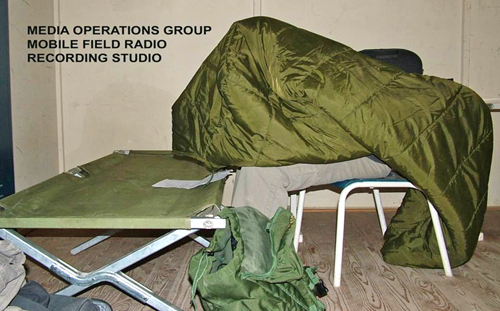
Johnny George <vo[at]johnnygeorge.com> Johnny George Communications Inc.: I completely understand why many of us have an “on the road” mobile set-up. I do too. A Dell laptop, loaded with 5 GB of RAM and 100GB HD. I use Studio One as my editing software and my alternate mic, Rode NT-2A. However, I really never take this on the road when I go on vacation, because that is MY time to decompress and reinvigorate myself from 51 weeks of work. I prefer to spend quality time with my family without distractions.
I respect all my brethren who take their work with them on vacation. That is their personal choice. I however, just prefer not to. I always warn my clients at 4 weeks, 3 weeks, 2 weeks and week of my break so I can work ahead on jobs or so they can plan accordingly. I did however, on my last break when touring Phoenix, arrange for a recording session at the Bonneville Broadcast facility to cut 2 spots for a client in Florida and an audition during Faffcon 4 for one of my people. That was an exception to my rule. I need time away from the studio and many do too. BTW… all the warnings in the world won’t stop that last minute or in the middle of your vacation, “I need this!” (Sorry, not home.)
More power to you if you can do both. I just need downtime since I don’t vacation but once a year.
Jeff Berlin <yeti[at]squirpy.com> Voice Warrior, www.jeffberlin.com: I always have to be ready for VO work. When I’m out riding my bicycle, I bring an Apogee Mic. Along a quiet road, or in a forested area, I’ve used the MiC and Twisted Wave on my iPhone to crank out useable VO. Beyond that, I have mobile rigs for traveling with and without a car. An SUV is a great voice booth. I put a Harlan Hogan Porta Booth in the rear seat (fewer reflections back there), set up Pro Tools with an external drive, a Metric Halo ULN-2 interface, and Korg NanoKontrol as a controller. A “new” iPad with Verizon 4G LTE provides screaming fast internet access if you’re in a 4G area.
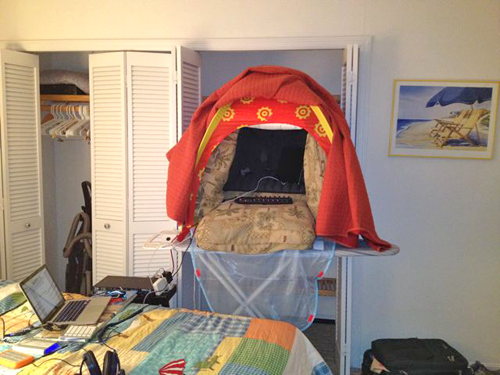
Without a car: For sound, I bring a little kid’s Starburst Beach tent. Doesn’t take up much space in the luggage. Once in a hotel, it provides a structure for creating an acoustically dead space using pillows, upholstery, blankets, comforters… whatever you can find. Just throw that hotel padding in and over the tent, set up the iPad inside and read your copy. How much gear I bring beyond that depends on the length of the trip. The Apogee MiC is fine for an overnight trip, but if it’s a weeklong vacation, I’ll bring the ULN-2, probably the best portable interface you can find for Pro Tools 9 or 10, although it’ll work with any Mac software.
Chris Stevens <chris[at]devaweb.co.uk> GMG Radio/Devaweb & Ignite Jingles: I’m about to change my portable studio. Currently it’s a Dell laptop with wireless mouse, USB powered external disc, and a set of fairly battered headphones, with Audition installed. I tried it with a Macbook Pro running Pro Tools a few years ago and it was a nightmare - too many things needed a direct USB socket. And with MBox Micro, iLok, ReFX dongle, external drive, MIDI keyboard etc., it simply wasn’t practical to produce music on the move. I ended up needing a powered USB hub, and the whole idea of the set-up was to avoid power supplies and stacks of wires.
But now that I’m doing lots of my own jingles (www.ignitejingles.com if you want a look), I want to be fully Mac again, even when on the road. Hopefully the combination of the new Macbook Pros, along with PT no longer needing an MBox, will make it more practical. I guess I could always use the SD slot as a small hard drive...
Something I’d always recommend - a 3G dongle. You can upload/download anywhere, and the data usage will normally be cheaper than some of those crazy hotel wi-fi charges!
Efrain Gonzalez <franko776[at]aol.com> SoundWave Riders, www.soundwaveriders.com: First of all, I’m a gear head, so I will go through a lot of gear to get the results I want until I find what works out best.
10 years ago I had my first taste of “portable” with a Casio MP3 watch. It only had 32mb of memory so it wouldn’t hold too many files but it allowed me to literally have my demo on my sleeve at all times. As a matter of fact, I met Dave Foxx in a production summit and had him evaluate my demo that way, and after that we kept in contact up to this day. He is probably one of the most down to earth, most knowledgeable people I have ever met in this industry and definitely someone to look up to in a personal and professional level. He’s just all around “cool people”.
Since then, I’ve been messing around for years now with trying to put together the perfect portable rig, and in that process I have gone through lots of interesting gear.
I do voice over and production work, and obviously with technology moving as fast as it has over the last few years, it is possible now to travel waaaay lighter than let’s say 5 years ago.
I originally started with Dynamic mics that could be plugged into the jack of the “audio in” port of a laptop and progressively moved up the chain. Then moved to a M-audio audio Firewire 410 (used a Pcmcia Firewire card for the laptop) with a Sennheiser 441-U and a pair of Sony MDR-7506 headphones and a Wi-Fi card. NOTE: if you have a dumb TSA agent check your bag, and they have no clue what a Firewire interface is, you will be asked A LOT of questions and in some cases have your bag scanned by a bomb detector or an explosives sniffing dog (sigh...).
After that, I opted to go with USB, so I got an M-audio Fastrack USB and used my Sennheiser with it.
Then I moved into lighter territory with a laptop loaded with Audition, wireless mouse, a Samson C01-U, pair of Sony MDR-7506 headphones and a Wi-Fi card. It wasn’t the best of microphones, but I did learn one thing that made life a lot easier. If you are used to having “a sound”, and you want to travel with unconventional gear, the best thing you can do is run it through its paces in the studio, get very familiar with it, and replicate the sound that you have as much as possible with the equipment you already know. In my case I plug in a new mic, find my sound in my studio gear, and create a series of presets in Audition that I would then either write down and/or save, then whenever I went somewhere it was just as simple as applying the presets and voila! Perfect audio regardless of the headphones I had on hand. It takes some self training and adapting, but in the end it’s well worth it. I normally stop using my studio monitors and go directly to the headphones I’m taking with me 2 days prior to going anywhere, that way my ears will be ready to go when I switch.
I have evolved from those days into better mics, better laptops, but I have downgraded to smaller headphones. I now use a pair of Skullcandy titanium headphones (way smaller and less expensive to carry around than the Sony’s). But again, I find myself doing the same thing, learning my gear, getting comfortable with the sound and setting up what works for me.
Current setup (keep in mind I also do production, graphic design and video and that’s why I need a big monster laptop): Asus G74S with Audition, Blue Icicle USB adapter, Rode NT1 original with a wind screen (plan B is an M-audio USB producer mic and plan C is a Zoom H4 USB interface/portable recorder and plan D -- I know, too many plans -- an Ipod Touch with a Blue Mikey microphone. Hey, I can always run around and listen to music with it when I travel, and the mic doesn’t take any space at all. I can record on it and send to the laptop without problems for fine tuning) with Skullcandy headphones and a couple of 16GB pen drives as a backup for my sound libraries. Always remember, trust your gear, but things happen, so have a backup plan. In my “worst case scenario” I can always plug into the H4 or use the built in mics, record the file and pretty much go anywhere there is a computer with the SD card and upload or use my Ipod Touch with my Mikey and email straight from the unit. Ok, so you won’t be able to process your audio… WRONG! You can always go anywhere with a computer (Kinko’s, hotel business center, etc.) and use LOGMEIN (free), load to your machine at home and run the presets you had (sneaky isn’t it?).
Now, when I’m in my own car it’s a different story. Call me strange, but I have a setup loaded in my car as well just in case (that way I don’t have to carry my big gear around at all times), which consists of another laptop on a police looking mount (I get asked if I’m a cop all the time and it seems to work better than my car alarm hahaha), an Audio-Technica 2020 USB, and have everything running through a Bluetooth dongle to my stereo system in the car. I’ve been in spots in which I have a last minute VO and I’m not in the studio and actually record it in my car, and clients have not been able to tell the difference. In most cases, I get asked where did I find a studio and get really confused answers (“You are crazy” is probably the most common one) followed by laughter from them when I explain.
And when I know I won’t be doing anything but audio, then I just leave the big bulky Asus and bag an Acer ONE netbook!
Now, I have had some interesting road trips; once I was in the back of a Pickup going down to Texas on the highway using my laptop to produce and send a couple of spots for a client. I recorded the VO for that session in the cabin while we refueled, hahaha.
Another time I was in Venezuela, and couldn’t find a quiet enough place to record, so I jumped in my mother-in-law’s Renault Logan (small car) and used it as a booth!
Which leads to the other question: What do you do about noise? Well, if you read this you noticed that most times I resort to a car! Cars are made to keep as much noise as possible out and maintain a certain level of acoustics inside (of course, run the AC or heater for a while so you’ll be comfortable, don’t record with the engine ON and try to park somewhere far from heavy traffic, oh, and don’t try to record or produce while driving, not a good idea...).
Second, it all depends where I go. If I’m in a hotel I will use the big bulky comforters and pitch a tent of sorts and make an improvised booth. The big thick curtains from hotel rooms also work well, as they are pretty good at damping noise. If I know I’m going somewhere that I will not have all those things available, then I bag a makeshift vocal booth made out of the first concept Harlan Hogan created, which consisted of acoustic squares cut up in a fold-able storage lined box (still the cheapest and most effective way to make a booth of sorts that works for under $25). True I could buy the latest one he made, but I’m not worried about looking pretty or all the other new options. At the end of the day clients won’t care; they care about the sound itself. If you are doing just VO, then you’ll know that it has to be as clean as possible, but if you are doing audio production with your VO then you know that you can always mask some imperfections in the room with effects and music, although that doesn’t mean you are not shooting to get the best VO possible.
Also, keep in mind you need to maintain contact with everyone, and sometimes you won’t have your cell phone (especially if you go abroad) with you at your hip to take care of business.
So, I resort to a few tricks on that side too. One of them is my Ipod Touch (with Wi-Fi can be used for just about anything like Skype or as a file up loader without having to unpack the rest of your gear). Also I use a Magic Jack USB unit for regular calls, but so I don’t have to give out too many numbers to clients I use Google voice and give that number out, that way a client can leave a message that I can check on my email and I will call them back. Now if your clients are more Techy you can always use Skype and get in touch with them at any time. Pretty much nowadays there are very extreme few places that don’t have Wi-Fi, so keeping that in mind. Chances are you can walk into a Burger joint in Venezuela (I have done this), check your emails, talk to clients, eat lunch and shoot emails with VO’s or in some cases, load them to a shared Dropbox account or to my own server and send the clients a link.
It’s nice to live in a world where you can check your email on your phone, record a VO in your car, walk into a coffee shop or a book store, produce a spot and email it to a client while you sip on a good cup of coffee. Portability gives you an ever-changing scenery and getting out of the studio is definitely a liberating experience.
Alan Peterson <apeterson[at]radioamerica.org> Radio America: I don’t have a portable studio per se, but there are two new products that have my close attention and want to try out: “Voddio” from Vericorder in British Columbia, which puts six audio tracks or two tracks of video + editing on an iPad; and the iSeries of plug-in microphones from MicW Audio. These mics have lots of clarity, but are unfortunately lacking in bass response. Still, they are receiving attention and I want to know why.
Portable media devices like Smartphones have made field audio acquisition easy and effective; but because anyone can do it, it just doesn’t look as cool anymore as when we showed up somewhere with a shoulder-slung DAT deck and an RE-20 ;^)
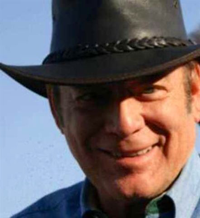 Don Elliot <donelliot[at]gmail.com>: Everybody and his brother is going to send you pictures of microphones and equipment. I’m going to send you a picture of the business and the thing that talks into the mic that makes the sale. Hi everybody! Howdy y’all!
Don Elliot <donelliot[at]gmail.com>: Everybody and his brother is going to send you pictures of microphones and equipment. I’m going to send you a picture of the business and the thing that talks into the mic that makes the sale. Hi everybody! Howdy y’all!
I’m speaking generalizations because of a great lack of time to go into detail but I can tell you the new era of doing this kind of work is going to be on iPhones and iPads. The challenge is finding microphones that will be not rejected through the USB low current limitations of such devices.
The second challenge is the acoustics in the room that you are recording in, and because of the unpredictability of your travel destinations. Pillows and blankets work great wherever you are.
And the third major issue is that the iPhone and iPad devices are content consumers not content generators, and in their design the generation of an MP3 to be outputted from it is non-existing. There are several solutions to this. If you ask Apple they will tell you to plug into iTunes on your laptop and convert to MP3 and send it. But the whole idea is to not have to carry a laptop with you in addition to the iPad or iPhone.
The most exciting solution existing right now is a program called TwistedWave that allows you to edit voice tracks, send them to an FTP and have the consumer client download from a link. Send them with their choice of formats including but not limited to MP3, Wave Ogg Vorbis and AAC.
Blaine Parker <bp[at]slowburnmarketing.com> Slow Burn Marketing: If you have a studio mic in your carry-on, TSA agents tend to look at it two or three times, scratch their heads, and either ignore it or say they want to inspect.
So, I’m going through security at LAX, waiting for the bag to come out of the X-ray. The guy keeps studying the monitor.
Finally, I say, “It’s a microphone.”
“TLM 103?”
“Uh, yeah.”
“I have a U-87.”
The bag comes rolling out of the machine.
Only in Los Angeles.
Anyway, when I carry (which is become less frequent—I’m just tired of it), I pack a Neumann TLM-103 (matches my home studio), a CEntrance MicPort Pro (much more convenient than the M-Audio box I was schlepping), and a Core i7 ThinkPad w/ 8MB RAM running Sony Vegas Pro 10. I have recorded VO for national TV in hotel rooms and guest room closets with this rig.
I’ve also built plenty of recording “booths” out of hotel room pillows and sofa cushions.
The only missing piece is a decent mic stand. For air travel, I have an adequate, collapsible desktop item that has its limitations. Traveling by car, I just grab a boom stand from the closet. I’d love something in between that might be TSA compliant.
♦

